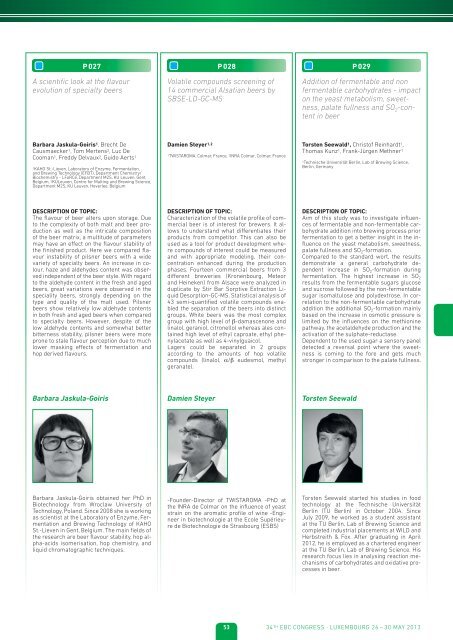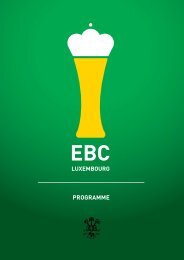please click here for download. - the 34th European Brewery ...
please click here for download. - the 34th European Brewery ...
please click here for download. - the 34th European Brewery ...
Create successful ePaper yourself
Turn your PDF publications into a flip-book with our unique Google optimized e-Paper software.
P 027<br />
A scientific look at <strong>the</strong> flavour<br />
evolution of specialty beers<br />
P 028<br />
Volatile compounds screening of<br />
14 commercial Alsatian beers by<br />
SBSE-LD-GC-MS<br />
P 029<br />
Addition of fermentable and non<br />
fermentable carbohydrates - impact<br />
on <strong>the</strong> yeast metabolism, sweetness,<br />
palate fullness and SO 2 -content<br />
in beer<br />
Barbara Jaskula-Goiris 1 , Brecht De<br />
Causmaecker 1 , Tom Mertens 2 , Luc De<br />
Cooman 1 , Freddy Delvaux 2 , Guido Aerts 1<br />
1KAHO St.-Lieven, Laboratory of Enzyme, Fermentation,<br />
and Brewing Technology (EFBT), Department Chemistry/<br />
Biochemistry - LFoRCe, Department M2S, KU Leuven, Gent,<br />
Belgium, 2 KULeuven, Centre <strong>for</strong> Malting and Brewing Science,<br />
Department M2S, KU Leuven, Heverlee, Belgium<br />
Damien Steyer 1,2<br />
1TWISTAROMA, Colmar, France, 2 INRA Colmar, Colmar, France<br />
Torsten Seewald 1 , Christof Reinhardt 1 ,<br />
Thomas Kunz 1 , Frank-Jürgen Methner 1<br />
1Technische Universität Berlin, Lab of Brewing Science,<br />
Berlin, Germany<br />
DESCRIPTION OF TOPIC:<br />
The flavour of beer alters upon storage. Due<br />
to <strong>the</strong> complexity of both malt and beer production<br />
as well as <strong>the</strong> intricate composition<br />
of <strong>the</strong> beer matrix, a multitude of parameters<br />
may have an effect on <strong>the</strong> flavour stability of<br />
<strong>the</strong> finished product. Here we compared flavour<br />
instability of pilsner beers with a wide<br />
variety of specialty beers. An increase in colour,<br />
haze and aldehydes content was observed<br />
independent of <strong>the</strong> beer style. With regard<br />
to <strong>the</strong> aldehyde content in <strong>the</strong> fresh and aged<br />
beers, great variations were observed in <strong>the</strong><br />
speciality beers, strongly depending on <strong>the</strong><br />
type and quality of <strong>the</strong> malt used. Pilsner<br />
beers show relatively low aldehyde contents<br />
in both fresh and aged beers when compared<br />
to specialty beers. However, despite of <strong>the</strong><br />
low aldehyde contents and somewhat better<br />
bitterness stability, pilsner beers were more<br />
prone to stale flavour perception due to much<br />
lower masking effects of fermentation and<br />
hop derived flavours.<br />
DESCRIPTION OF TOPIC:<br />
Characterization of <strong>the</strong> volatile profile of commercial<br />
beer is of interest <strong>for</strong> brewers. It allows<br />
to understand what differentiates <strong>the</strong>ir<br />
products from competitor. This can also be<br />
used as a tool <strong>for</strong> product development w<strong>here</strong><br />
compounds of interest could be measured<br />
and with appropriate modeling, <strong>the</strong>ir concentration<br />
enhanced during <strong>the</strong> production<br />
phases. Fourteen commercial beers from 3<br />
different breweries (Kronenbourg, Meteor<br />
and Heineken) from Alsace were analyzed in<br />
duplicate by Stir Bar Sorptive Extraction Liquid<br />
Desorption-GC-MS. Statistical analysis of<br />
43 semi-quantified volatile compounds enabled<br />
<strong>the</strong> separation of <strong>the</strong> beers into distinct<br />
groups. White beers was <strong>the</strong> most complex<br />
group with high level of β-damascenone and<br />
linalol, geraniol, citronellol w<strong>here</strong>as ales contained<br />
high level of ethyl caproate, ethyl phenylacetate<br />
as well as 4-vinylguaicol.<br />
Lagers could be separated in 2 groups<br />
according to <strong>the</strong> amounts of hop volatile<br />
compounds (linalol, α/β eudesmol, methyl<br />
geranate).<br />
DESCRIPTION OF TOPIC:<br />
Aim of this study was to investigate influences<br />
of fermentable and non-fermentable carbohydrate<br />
addition into brewing process prior<br />
fermentation to get a better insight in <strong>the</strong> influence<br />
on <strong>the</strong> yeast metabolism, sweetness,<br />
palate fullness and SO 2 -<strong>for</strong>mation.<br />
Compared to <strong>the</strong> standard wort, <strong>the</strong> results<br />
demonstrate a general carbohydrate dependent<br />
increase in SO 2 -<strong>for</strong>mation during<br />
fermentation. The highest increase in SO 2<br />
results from <strong>the</strong> fermentable sugars glucose<br />
and sucrose followed by <strong>the</strong> non-fermentable<br />
sugar isomaltulose and polydextrose. In correlation<br />
to <strong>the</strong> non-fermentable carbohydrate<br />
addition <strong>the</strong> additional SO 2 -<strong>for</strong>mation mainly<br />
based on <strong>the</strong> increase in osmotic pressure is<br />
limited by <strong>the</strong> influences on <strong>the</strong> methionine<br />
pathway, <strong>the</strong> acetaldehyde production and <strong>the</strong><br />
activation of <strong>the</strong> sulphate-reductase.<br />
Dependent to <strong>the</strong> used sugar a sensory panel<br />
detected a reversal point w<strong>here</strong> <strong>the</strong> sweetness<br />
is coming to <strong>the</strong> <strong>for</strong>e and gets much<br />
stronger in comparison to <strong>the</strong> palate fullness.<br />
Barbara Jaskula-Goiris<br />
Damien Steyer<br />
Torsten Seewald<br />
Barbara Jaskula-Goiris obtained her PhD in<br />
Biotechnology from Wroclaw University of<br />
Technology, Poland. Since 2008 she is working<br />
as scientist at <strong>the</strong> Laboratory of Enzyme, Fermentation<br />
and Brewing Technology of KAHO<br />
St.-Lieven in Gent, Belgium. The main fields of<br />
<strong>the</strong> research are beer flavour stability, hop alpha-acids<br />
isomerisation, hop chemistry, and<br />
liquid chromatographic techniques.<br />
-Founder-Director of TWISTAROMA -PhD at<br />
<strong>the</strong> INRA de Colmar on <strong>the</strong> influence of yeast<br />
strain on <strong>the</strong> aromatic profile of wine -Engineer<br />
in biotechnologie at <strong>the</strong> Ecole Supérieure<br />
de Biotechnologie de Strasbourg (ESBS)<br />
Torsten Seewald started his studies in food<br />
technology at <strong>the</strong> Technische Universität<br />
Berlin (TU Berlin) in October 2004. Since<br />
July 2009, he worked as a student assistant<br />
at <strong>the</strong> TU Berlin, Lab of Brewing Science and<br />
completed industrial placements at WILD and<br />
Herbstreith & Fox. After graduating in April<br />
2012, he is employed as a chartered engineer<br />
at <strong>the</strong> TU Berlin, Lab of Brewing Science. His<br />
research focus lies in analysing reaction mechanisms<br />
of carbohydrates and oxidative processes<br />
in beer.<br />
53 34 TH EBC CONGRESS · LUXEMBOURG 26 – 30 MAY 2013





